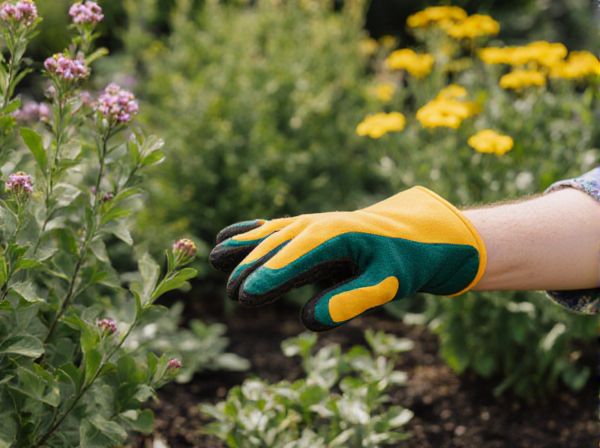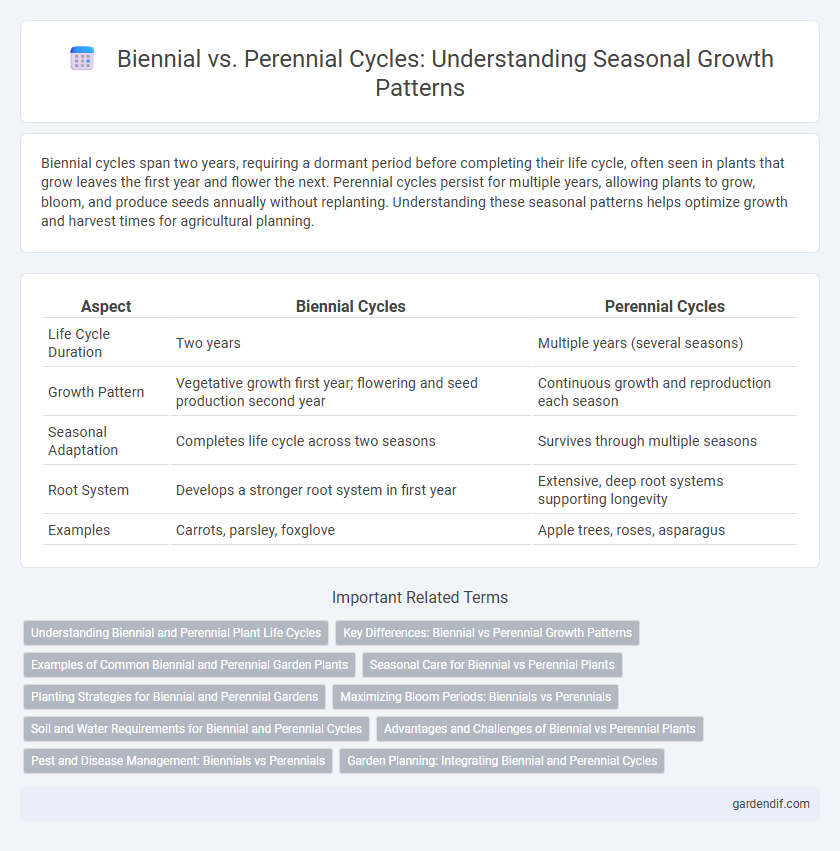
Biennial cycles vs Perennial cycles Illustration
Biennial cycles span two years, requiring a dormant period before completing their life cycle, often seen in plants that grow leaves the first year and flower the next. Perennial cycles persist for multiple years, allowing plants to grow, bloom, and produce seeds annually without replanting. Understanding these seasonal patterns helps optimize growth and harvest times for agricultural planning.
Table of Comparison
| Aspect | Biennial Cycles | Perennial Cycles |
|---|---|---|
| Life Cycle Duration | Two years | Multiple years (several seasons) |
| Growth Pattern | Vegetative growth first year; flowering and seed production second year | Continuous growth and reproduction each season |
| Seasonal Adaptation | Completes life cycle across two seasons | Survives through multiple seasons |
| Root System | Develops a stronger root system in first year | Extensive, deep root systems supporting longevity |
| Examples | Carrots, parsley, foxglove | Apple trees, roses, asparagus |
Understanding Biennial and Perennial Plant Life Cycles
Biennial plants complete their life cycle over two growing seasons, typically focusing on vegetative growth in the first year and flowering, seed production, and death in the second year. Perennial plants live for multiple years, often undergoing repeated cycles of flowering and seed production, with many species entering dormancy during unfavorable seasons. Understanding these distinct life cycles aids in effective cultivation, pest management, and ecological planning.
Key Differences: Biennial vs Perennial Growth Patterns
Biennial plants complete their life cycle over two years, typically growing foliage in the first year and flowering in the second, while perennial plants live for multiple years, flowering and growing continuously each season. Biennial growth patterns emphasize a two-year developmental strategy with a dormant winter phase, whereas perennial cycles incorporate seasonal dormancy but maintain persistent root systems for regrowth. The key difference lies in their life span and reproductive timing: biennials invest in a biennial reproductive phase, whereas perennials sustain productivity across many growing seasons.
Examples of Common Biennial and Perennial Garden Plants
Common biennial garden plants include foxglove (Digitalis purpurea), parsley (Petroselinum crispum), and sweet William (Dianthus barbatus), which complete their life cycle in two years, focusing energy on foliage growth the first year and flowering the second. Popular perennial garden plants such as peonies (Paeonia spp.), hostas (Hosta spp.), and daylilies (Hemerocallis spp.) live for multiple years, blooming annually once mature. Understanding these life cycles helps gardeners plan seasonal planting and garden maintenance effectively.
Seasonal Care for Biennial vs Perennial Plants
Biennial plants complete their life cycle over two growing seasons, requiring precise seasonal care such as nurturing seedlings in the first year and encouraging flowering in the second. Perennial plants, by contrast, live for multiple years and benefit from seasonal maintenance like pruning, fertilizing, and mulching to promote sustained growth and flowering. Tailoring watering schedules and soil preparation according to the plant's seasonal phase enhances overall health and productivity in both biennial and perennial species.
Planting Strategies for Biennial and Perennial Gardens
Biennial plants complete their life cycle in two years, requiring planting strategies that emphasize biennial rotation and soil renewal to optimize growth and flowering in the second season. Perennial plants live for multiple years, demanding strategies focused on sustainable soil health, minimal disturbance, and strategic pruning to encourage long-term vitality and productivity. Combining biennial and perennial cycles within garden design promotes biodiversity and continuous seasonal interest through staggered flowering and harvest periods.
Maximizing Bloom Periods: Biennials vs Perennials
Biennial plants complete their lifecycle in two years, allowing gardeners to maximize bloom periods by planning sequential planting in alternating years. Perennial plants regrow annually from the same root system, providing continuous blooms over multiple seasons without replanting. Strategically combining biennials and perennials extends flowering displays, optimizing garden aesthetics and resource efficiency throughout the growing season.
Soil and Water Requirements for Biennial and Perennial Cycles
Biennial cycles demand moderate soil moisture and nutrient levels, relying on a two-year growth period to complete their life cycle, which allows for nutrient accumulation during the first year and intensive water use during the second. Perennial cycles, with their multi-year lifespan, develop deeper root systems enhancing soil structure and increasing water retention, reducing irrigation needs over time. Efficient management of soil organic matter and consistent monitoring of moisture levels optimize growth in both biennial and perennial crop cycles.
Advantages and Challenges of Biennial vs Perennial Plants
Biennial plants complete their life cycle in two years, allowing them to allocate resources efficiently between vegetative growth and reproduction, often producing robust root systems and higher seed yields. Perennial plants persist for multiple years, offering advantages such as soil stabilization, reduced planting costs, and consistent yield over time, but may require longer establishment periods and management of disease buildup. Biennials face challenges with a limited growing season and vulnerability during the first year, while perennials must balance energy between growth and maintenance, potentially limiting rapid productivity.
Pest and Disease Management: Biennials vs Perennials
Biennial crops, such as carrots and beets, complete their life cycle in two years, which can disrupt pest and disease cycles by alternating planting schedules and reducing host plant availability. Perennial plants, like fruit trees and grapes, require long-term pest and disease management strategies due to their continuous presence, which can lead to persistent pest populations and increased disease buildup. Integrated pest management for perennials often involves regular monitoring, targeted treatments, and cultural practices to minimize infestations, whereas biennials benefit from crop rotation and fallow periods that naturally limit pathogen survival.
Garden Planning: Integrating Biennial and Perennial Cycles
Garden planning benefits from integrating biennial cycles, which involve plants completing their lifecycle in two years, with perennial cycles where plants live and produce for multiple seasons. Strategically combining biennial vegetables like carrots and beets with perennial herbs such as thyme and rosemary maximizes soil health, biodiversity, and yield continuity. This approach ensures seasonal succession and resource-efficient gardening by balancing rapid-growing biennials with long-term perennial crops.
Biennial cycles vs Perennial cycles Infographic

 gardendif.com
gardendif.com